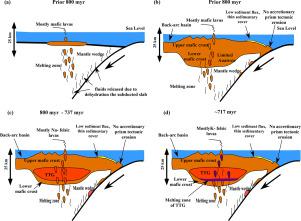Geoscience Frontiers ( IF 8.9 ) Pub Date : 2021-01-26 , DOI: 10.1016/j.gsf.2021.101148 Ali A. Khudeir , Jean-Louis Paquette , Kirsten Nicholson , Åke Johansson , Tyrone O. Rooney , Sadiq Hamid , Mohamed A. El-Fadly , Loretta Corcoran , Shawn J. Malone , Mohamed Ali Abu El-Rus

|
The Shaitian granite complex (SGC) spans more than 80 Ma of crustal growth in the Arabian–Nubian Shield in southeast Egypt. It is a voluminous composite intrusion (60 km2) comprising a host tonalite massif intruded by subordinate dyke-like masses of trondhjemite, granodiorite and monzogranite. The host tonalite, in turn, encloses several, fine-grained amphibolite enclaves. U-Pb zircon dating indicates a wide range of crystallization ages within the SGC (800 ± 18 Ma for tonalites; 754 ± 3.9 Ma for trondhjemite; 738 ± 3.8 Ma for granodirite; and 717 ± 3.2 Ma for monzogranite), suggesting crystallization of independent magma pulses. The high positive εNdi (+6–+8) indicate that the melting sources were dominated by juvenile material without any significant input from older crust. Application of zircon saturation geothermometry indicates increasing temperatures during the generation of melts from 745 ± 31 °C for tonalite to 810 ± 25 °C for trondhjemite; 840 ± 10 °C for granodiorite; and 868 ± 10 °C for monzogranite. The pressure of partial melting is loosely constrained to be below the stability of residual garnet (<10 kbar) as inferred from the almost flat HREE pattern ((Gd/Lu)N = 0.9–1.1), but >3 kbar for the stability of residual amphibole as inferred from the significantly lower NbN and TaN compared with LREEN and the sub-chondrite Nb/Ta ratios exhibited by the granitic phases. The inverse relation between the generation temperatures and the ages estimates of the granitoid lithologies argue against a significant role of fractional crystallization. The major and trace element contents indicate the emplacement of SGC within a subduction zone setting. It lacks distinctive features for melt derived from a subducted slab (e.g. high Sr/Y and high (La/Yb)N ratios), and the relatively low MgO and Ni contents in all granite phases within the SGC suggest melting within the lower crust of an island arc overlying a mantle wedge. Comparison with melts produced during melting experiments indicates an amphibolite of basaltic composition is the best candidate as source for the tonalite, trondhjemite and granodiorite magmas whereas the monzogranite magma is most consistent with fusion of a tonalite protolith. Given the overlapping Nd-Sr isotope ratios as well as several trace element ratios between monzogranite and tonalite samples, it is reasonable to suggest that the renewed basaltic underplating may have caused partial melting of tonalite and the emplacement of monzogranite melt within the SGC. The emplacement of potassic granite (monzogranite) melts subsequent to the emplacement of Na-rich granites (tonalite-trondhjemite-granodiorite) most likely suggests major crustal thickening following arc collision and amalgamation into the over thickened proto-crust of the Arabian-Nubian microcontinent. Eventually, after complete consolidation, the whole SGC was subjected to regional deformation, most probably during accretion to the Saharan Metacraton (arc–continent collisions) in the late Cryogenian -Ediacaran times (650–542 Ma).
中文翻译:

关于阿拉伯-努比亚盾牌的克拉通化:来自埃及东南沙漠的片麻岩花岗岩的约束
在埃及东南部的阿拉伯-努比亚盾构中,Shaitian花岗岩复合体(SGC)跨越了80 Ma以上的地壳生长。它是一个庞大的复合岩体侵入体(60 km 2),包括由斜长石,花岗闪长岩和辉绿岩等次要的堤状块体侵入的主体斜长石地块。主体色母石依次包封了几个细粒度的角闪石围墙。U-Pb锆石定年表明SGC内的结晶年龄范围很广(同色岩为800±18 Ma;硬榴石为754±3.9 Ma;花岗辉石为738±3.8 Ma;单长花岗岩为717±3.2 Ma),表明独立的结晶岩浆脉冲。高正ε恩迪(+ 6– + 8)表明,融化源主要是幼年物质,没有来自旧地壳的大量投入。锆石饱和地热法的应用表明,在熔融物生成过程中,温度升高,从方钠石的745±31°C到白云母的810±25°C。花岗闪长岩为840±10°C; 辉长花岗岩为868±10°C。从几乎平坦的HREE模式((Gd / Lu)N = 0.9–1.1)推断,部分熔化的压力被宽松地限制为低于残留石榴石的稳定性(<10 kbar ),但是对于大于3 kbar的稳定性,由Nb N和Ta N明显低于LREE N推断出的剩余闪石花岗岩相表现出亚球粒岩的Nb / Ta比。生成温度与花岗岩岩性年龄估计值之间的反比关系反对分数结晶的重要作用。主要元素和痕量元素的含量指示了SGC在俯冲带环境中的位置。对于俯冲板坯产生的熔体,它缺乏鲜明的特征(例如,高Sr / Y和高(La / Yb)N比率),并且SGC内所有花岗岩相中MgO和Ni含量相对较低,这表明在覆盖地幔楔的岛弧下部地壳内熔化。与熔融实验中产生的熔体进行比较表明,玄武岩组成的角闪石是斜纹岩,长白云母和花岗闪长岩岩浆的最佳来源,而辉长花岗岩岩浆与斜纹岩原石的熔融最一致。考虑到重叠的Nd-Sr同位素比率以及在辉锰矿和方钠石样品之间的几种微量元素比率,有理由认为,新的玄武岩底层镀层可能导致了辉石的部分熔融和SGC内辉辉岩熔体的位置。钾含量高的花岗岩(辉长花岗岩)的位置在富钠花岗岩(高岭石-长晶石-辉长岩)的位置之后融化,最有可能表明弧碰撞和合并成阿拉伯-努比亚微大陆的超厚原壳后主要地壳增厚。最终,在完全固结之后,整个SGC都经历了区域变形,很可能是在深冷期-爱迪卡拉时期(650-542 Ma)的增生过程中撒哈拉大克拉通(弧-大陆碰撞)。


























 京公网安备 11010802027423号
京公网安备 11010802027423号